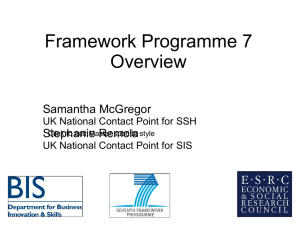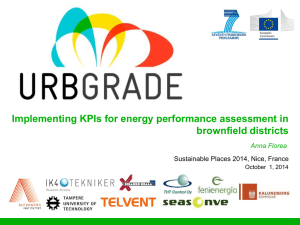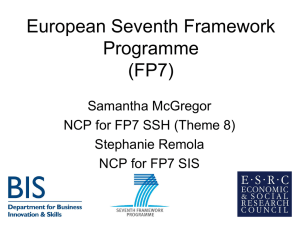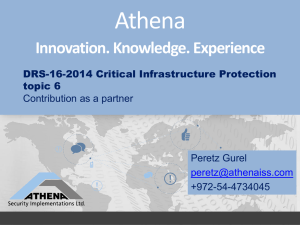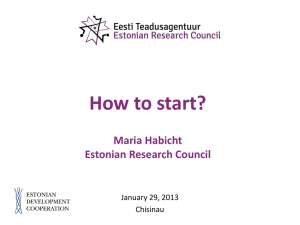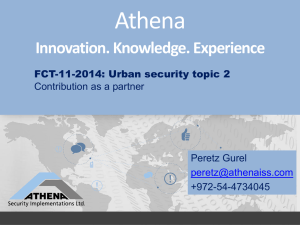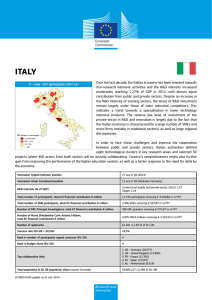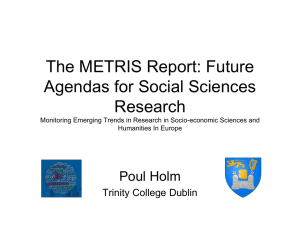lobbying - Associatie KU Leuven
advertisement
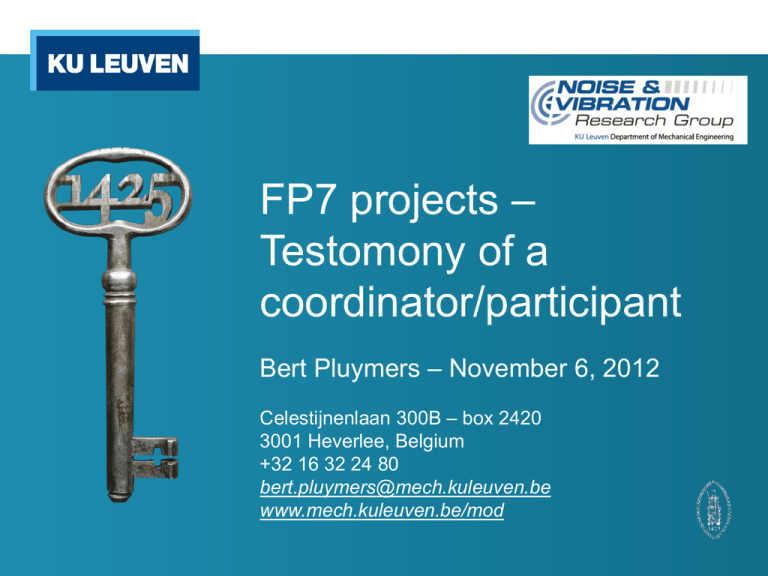
FP7 projects – Testomony of a coordinator/participant Bert Pluymers – November 6, 2012 Celestijnenlaan 300B – box 2420 3001 Heverlee, Belgium +32 16 32 24 80 bert.pluymers@mech.kuleuven.be www.mech.kuleuven.be/mod Disclaimer • Personal experience in EU FP7 project partnering, coordination and lobbying Overview • Discussion on two types of FP7 EU projects o o Marie Curie Training projects Collaborative research projects Team • KU Leuven - Department of Mechanical Engineering • Division of Production engineering, Machine design and Automation (PMA) • Noise and Vibration Research Group (MOD) • Research staff o o o o 5 academic and 1 associated 1 industrial research manager 9 senior postdoctoral researchers 59 PhD incl. 10 industrial PhD res. • Areas of research o o o o o Vibro-acoustics Structural reliability & uncertainty Multi-body dynamics Smart system dynamics Aero-acoustics Application domains - Energy and environment Transport and mobility Advanced manufacturing Health Some key numbers • • • • • • • September 2012 48 research projects (40% EU FP7 and COST) 50 personal fellowships (50% Marie Curie, 25% IWT Flanders) 10 industrial PhD’s (IWT Baekeland, Marie Curie or bilateral) IOF Mandate – Dynamics and mechatronics: oxygen for innovating industry LMS Chair on Vehicle Mechatronics Full list of projects: www.mech.kuleuven.be/mod/projects Spin-offs: LMS International, DAP/Co-Services, SoundTalks On-going FP7 & COST projects • • • • • • • • • • • • • • • • • • • • EU FP7 ITN, EMVeM: Energy efficiency Management for Vehicles and Machines (coordinator) • • 19 FP7 on-going projects 13 Marie Curie projects 5 as coordinator 1 COST Action in TUD as co-initiator and vice-chair EU FP7 EID, eLiQuiD: Best Engineering Training in Electric, Lightweight and Quiet Driving (coordinator) EU FP7 ITN, MARE-WINT: new MAterials and REliability in offshore WINd Turbines technology COST Action TUD, TU1105:NVH analysis techniques for design and optimization of hybrid and electric vehicles EU FP7 IP, ALIVE: Advanced High Volume Affordable Lightweighting for Future Electric Vehicles EU FP7 IP, ENLIGHT: Enhanced Lightweight Design EU FP7 CP, IDEALVENT: Integrated Design of Optimal Ventilation Systems for Low Cabin and Ramp Noise EU FP7 IEF, PAM: the Physics of Acoustic Materials (coordinator) EU FP7 ITN, FLOWAIRS: Silent Air Flows in transport, buildings and power generation EU FP7 ITN, ANADE: Advances in numerical and analytical tools for detached flow prediction EU FP7 IAPP, INTERACTIVE: Innovative Concept Modelling Techniques for Multi-Attribute Optimization of Active Vehicles EU FP7 ITN, GRESIMO: Best Training for Green and Silent Mobility EU FP7 ITN, IMESCON: Innovative Methods of Separated Flow Control in Aeronautics EU FP7 SME DASHWIN: Development of Advanced Shearography System for On-Site Inspection of Wind Turbine Blades EU FP7 IAPP, Tire-Dyn: Experimental and Numerical Analyses of the Dynamic Behavior of Rolling Tires (coordinator) EU FP7 IRSES, SUPERPANELS: Strengthening and Upholding the Performances of the new Engineered Research PANELS EU FP7 CP, ESTOMAD: Energy Software Tools for Sustainable Machine Design EU FP7 CP, EMBOCON: Embedded Optimization for Resource Constrained Platforms EU FP7 ITN, MID-FREQUENCY: CAE Methodologies for Mid-Frequency Analysis in Vibration and Acoustics (coordinator) EU FP7 ITN, VECOM: Vehicle Concept Modelling FP7 ITN MID-FREQUENCY • FP7 ITN MID-FREQUENCY (no. 214909), 01/10/2008 – 31/09/2012 • Main Topic: Mid-frequency vibro-acoustic simulation tools o Development of enhanced mid-frequency simulation methods o Benchmarking on academic and semi-industrial cases o Validation on industrial automotive and aerospace applications • Website: http://www.midfrequency.org • Project Partners: (12 partners – 8 countries) o Universities: K.U.Leuven (coord.: Wim Desmet, Bert Pluymers), ENSCachan, Univ. Cambridge, ECL, INSA Lyon, KTH, SAPIENZA Rome, ISVR o R&D Institutes: ViF o Industrial partners: EADS Astrium ST, LMS, Daimler FP7 ITN MID-FREQUENCY • Recruited 19 ESR’s and 4 ER’s o 8 15 different nationalities (Brazilian(2), Chinese, Colombian, Czech, Egyptian, French(2), German, Greek, Indian, Italian(6), Romanian, South Korean, Spanish, Tunisian, Turkish) Some ‘winning features’ of the projects • • • • • reduction of fragmentation on a topic of European relevance in line with research topics in top-down Collaborative Research Calls strong interaction industry-research centres-academia relevant university partners relevant industrial partners and active involvement o o • • • • • • industrial PhD’s (now emphasized with EID) Fellows work in teams clearly stipulated training/ToK programme strong transferable skills programme via Doctoral School detailed recruitment policy management expertise of the coordinator detailed fellow PhD trajectories ‘clearly’ and ‘detailed’, yet sufficient flexibility in view of Fellow’s profile/training needs (PhD research is difficult to plan) Some ‘lessons learned’ • • • • • • • recruitment is key!!! eligibility criteria are tight and evolving embed a management plan for solving recruitment issues training of the Fellow is a crucial project outcome consortium agreement is not mandatory 100% funding, also for industry initiate long-lasting relationships follow-up ITN/IAPP projects o with network partners o with Fellows!! • long and tedious administrative procedures (e.g. amendments) • build up a good relationship with your REA project officer • recruitment is key!!! Europe vs. Flanders • What makes EU research projects different from IWT/FWO/… research projects? o More strict/elaborate administrative procedures • Experience + support from LRD, DOC, FPO, IOF o Higher competition in getting funding • Quality (be specific) + networking + lobbying o More opportunities for cooperation • Screening of partners + networking o Cultural differences in cross border cooperation • Experience + support from LRD, DOC, FPO, IOF o International lobbying What is lobbying? • EUR-Lex: Lobbying = Interest representation • Quote: Therefore, it should be stressed once again that the Commission's definition of 'lobbying' did not include any negative value judgment. Lobbying was referred to as "activities carried out with the objective of influencing the policy formulation and decision-making processes of the European institutions“. The Commission explicitly underlined the legitimate and useful role of lobbying activities in a democratic system. • Various lobby organizations exist (often called associations): e.g. EARPA EARPA: Top-class independent automotive R&D Lobby associations – how to get involved? • Need active members • Vicious circle o The more active an association is, o The more influence it will have, o The more attractive it will become for members, o The more active an association can become.. o however, often associations are closed entities: why should they accept more members if the existing members are getting a sufficient return? • How to get in? o Via existing members (you need strategic partners) o Via key persons (personal networks) o Via ETP conferences and EU projects o Via colleagues => KU Leuven might already be in => IOF Why to lobby? • EU networking = a necessity for our research group o Transport vehicle industry => European industry • Not sufficient (large) players in Flemish region • Also large industry players cooperate on a European platform o o Transport research is very important for our research group: currently 19 FP7 projects running Transport R&D is a closed community – “not what you know but who you know” – but you can only fail once • Profiling as a research group => you are the best • Influencing future calls o o Getting to know relevant Project Officers in person They need input How to lobby? • Lobbying is a strategic choice and requires full force investment o Time • • • • “Out of sight is out of mind” The deal is always closed at the meeting you did not attend Networking – formal but at least as important informal Being active: position papers, SRA’s, ... • o There is always a lack of people to write things Money (travel/accommodation/fees) • Exploit being close to Brussels • Drawback: we often skip informal networking events (travel back home) • Financial support via DOC & IOF How to lobby? • Lobbying is a strategic choice and requires full force investment o If not full force investment (“let’s see how things go” mentality) • In key areas: • Do not bother, mainly waste of time • Marginal return • A network needs to be built up and kept active • Possible negative effect: you will not be taken seriously • In side areas: • Can be ideal for expanding your network • Can leverage outcomes in your key areas (e.g. by bringing in new ideas) • E.g. key area: transport // side areas: ICT and NMP Opportunities for universities • Universities are often considered as objective parties • Possibilities for project participation if o You are willing to do the work • Companies have vague ideas but need • Scientific embedding • Somebody to take the lead in proposal preparation You are known and trusted by the companies • Profiling => don’t be afraid to call yourself the best o Make sure that you can do what you promised o You can only fail once o Acknowledgements We gratefully acknowledge the European Commission for its support of the Marie Curie program, including the running FP7 Marie Curie ITN projects MID-FREQUENCY, VECOM, IMESCON, FLOWAIRS, ANADE, GRESIMO and the FP7 Marie Curie IAPP projects TIRE-DYN and INTERACTIVE Contact • Bert Pluymers Celestijnenlaan 300B – box 2420 3001 Heverlee, Belgium +32 16 32 24 80 bert.pluymers@mech.kuleuven.be www.mech.kuleuven.be/mod
